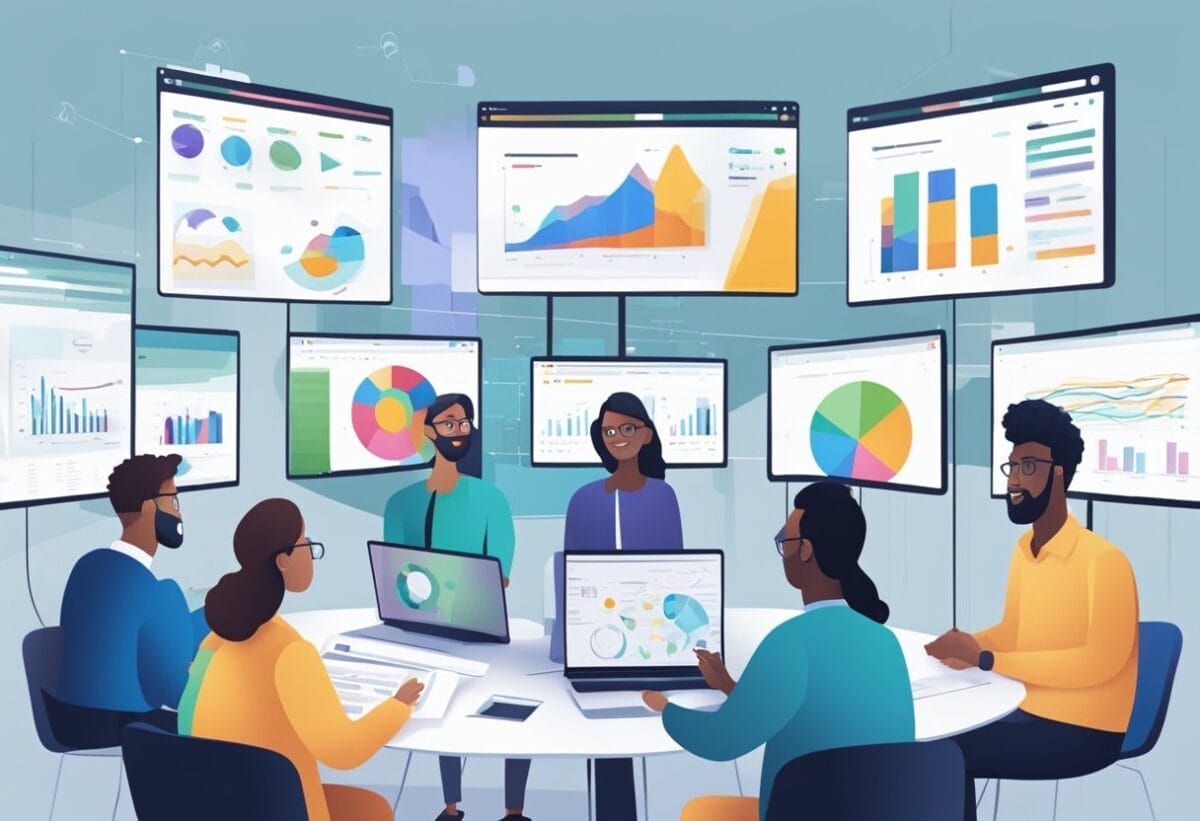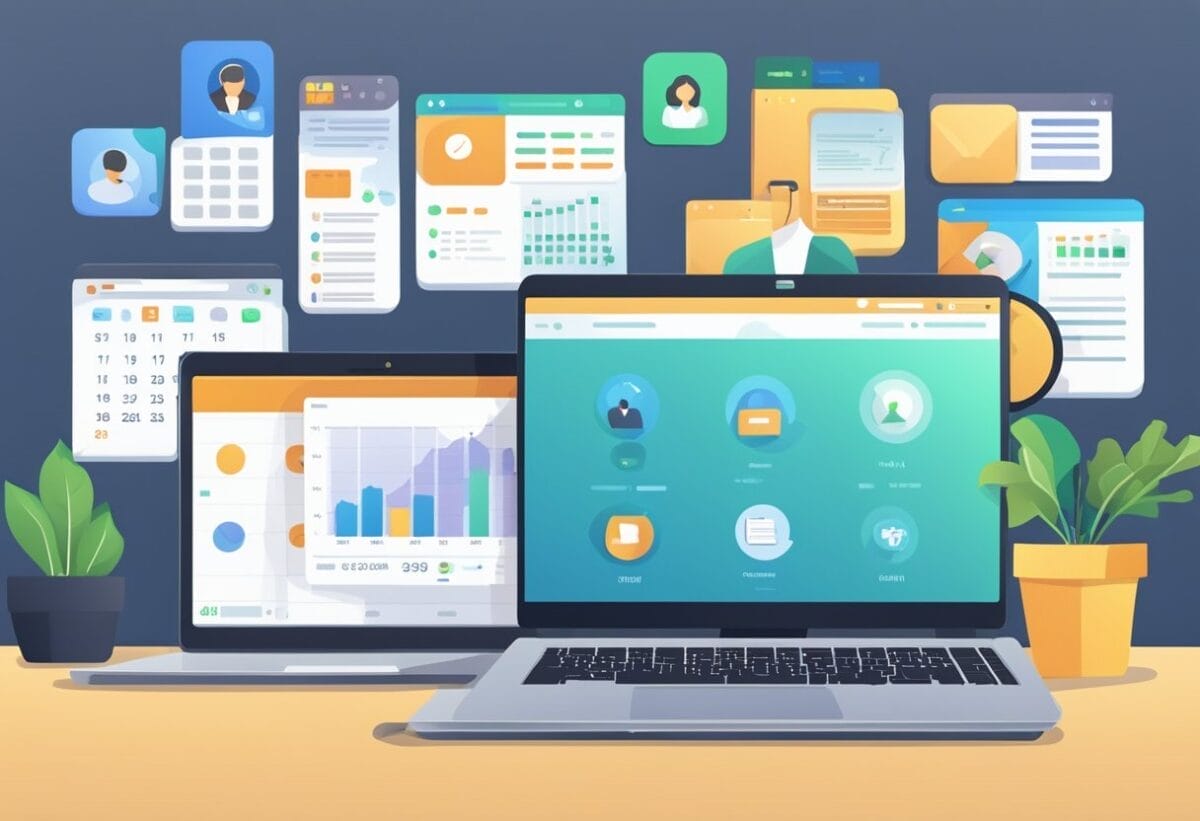With 85.2% of all 1-on-1 meeting happens remotely, online meeting is gaining in popularity especially as we are moving into remote working and hybrid work arrangements.
Studies shows 53% of professionals prefer online meeting compared to face-to-face as meetings online are generally shorter which increase focused work by over 22%. What that in mind, let’s take a look at what is exactly online meeting.
What Are Online Meetings in the Workplace?
Online meetings are virtual spaces where you connect with others in discussions through the virtual world, creating a virtual communication space where a group of individuals can share their thoughts and ideas freely replacing the need to travel to a common place for highly engaged discussions.
- Audio element of the communication brings in the tonality and verbal communication into the remote meeting environment. It helps to convey the message clearly to the participants of the online meeting.
- Video elements of the communication brings a human touch to remote interactions. It facilitates a virtual face-to-face interaction in a digital environment, helping mimic the dynamics of an in-person meeting.
Together with both the audio and visual elements, you can observe the tonality, body language and maintain a personal connection with your peers.
Who is Online Meeting For?
Online meetings are designed for professionals who are working remotely or engage in hybrid working, as well as connecting teams, clients, and partners spread across various locations.
With the emergency of remote work and hybrid work arrangement, these have made online meetings not just an added convenience at work, but necessary for the team to communicate and be productive.
Virtual meetings online enable team collaboration whether you’re at home, in a café, or halfway around the world.
Today, online meetings are about getting work done without the constraints of physical boundaries.
What is Required for Online Meeting?
For effective online meetings, equipment matters. You will minimally require to have:
- A stable internet connection
- A device with a microphone and camera
- A headphone for clarity.
Supportive software and equipment can help to enhance the productivity and effectiveness of online meeting even further:
- Software and tools for file sharing and screen sharing.
- Video conferencing which offers visual communication through body language and facial expression
- Cloud integration software and tools to ensures continuity and access to company resources during the online meeting.
What Are The Difference Between Online Meeting and Traditional Face-To-Face Meeting?
There are many differences between Online Meeting and Traditional Face-To-Face Meeting.
With that said, there are a few striking differences between online meeting and traditional face-to-face meeting.
| Areas | Online Meeting | Traditional Face-To-Face Meeting |
|---|---|---|
| Communication | Verbal and visual through video tools. | Direct verbal and non-verbal communication. |
| Location | Anywhere with an internet connection. | Specific physical location, often a meeting room. |
| Traveling | No travel needed; eliminates commute time and costs. | Requires commuting, which can be time-consuming and costly. |
| Accessibility | Enables participation from diverse locations and time zones. | Participation is limited to those physically present. |
| Costs | Lower costs (travel, venue). | Higher costs (travel, venue, meals). |
| Scheduling Flexibility | More flexible, suitable for different time zones. | Limited flexibility, challenges with coordination. |
| Equipment | Basic equipment (computer, webcam, microphone) is sufficient. | May require specialized meeting rooms and presentation tools. |
| Environmental Impact | Reduces carbon footprint by minimizing travel. | Involves travel, contributing to environmental impact. |
| Meeting Atmosphere | Participants in own environment, reduce stress. | Controlled atmosphere, potentially higher level of stress. |
Good communication keeps businesses thriving. And with today’s technology, geographical distances no longer restrict team collaboration or client interactions.
Anyway, I’ve found one really interesting video you want to watch, which talks about face-to-face meeting vs online meeting. It’s true, yet hilarious.
Types of Virtual Online Meetings
Virtual meetings have become essential in the modern workplace, providing various formats for collaboration, training, and presentations. Each type has its own set of tools and functions suited for specific purposes.

Video Conferencing
Video conferencing allows you to have virtual face-to-face meetings without being in the same room. With real-time video feeds, it’s like sitting across the table from your colleagues, even if you’re in different locations.
Web Conferencing
Web conferencing is a more interactive form of virtual meeting that enables you to share your screen, documents, or presentations with participants. This facilitates real-time collaboration and discussion.
Web Teleconferencing
Web teleconferencing combines the convenience of a conference call with the capabilities of the internet.
You’ll be able to talk with multiple people at once and may have some screen sharing capabilities, often with a focus on the audio communication.
Seminars
Virtual seminars, akin to their traditional counterparts, are typically educational sessions where you participate as a learner. You’ll listen to expert speakers who present on a specific topic.
Webinars
Webinars are online presentations where you can either present to an audience or attend as a participant. These are usually more structured and can involve Q&A sessions, polls, and interactive elements.
Types of Online Meeting Compared
| Meeting Type | Main Features | Best Use Case |
|---|---|---|
| Video Conferencing | Real-time video, personal interaction | Team meetings, client consultations |
| Web Conferencing | Screen sharing, interactive tools | Collaborative working sessions, training |
| Web Teleconferencing | Audio-focused, some screen sharing | Brief check-ins, large group discussions |
| Seminars | Educational content, passive learning | Training sessions, lectures |
| Webinars | Structured presentation, interactivity | Product demonstrations, educational webcast |
Gaining a better understanding on the different types of virtual online meetings and their best use cases offers insight into knowing which meeting type you should choose for your next meeting.
Hosting the right type of meeting that fulfil the specialized purpose can help increase the meeting effectiveness and reducing the length of the meeting.
Why Do We Need Online Meetings?
Today, online meetings have become invaluable for fostering collaboration and consistent workflow among teams. And as we are moving into hybrid and remote work environments, online meeting helps to ensure productivity and engagement levels remain high within the team as well as with external stakeholders.
Remote Work
Remote work means all your work and communication is performed online, and online meetings is your primary method for employees to stay connected.
Working from different locations can present challenges in communication, but online meetings help maintain a sense of unity within distributed teams.
They allow for real-time collaboration, ensuring that everyone can contribute their ideas and input as if they were in the same room.
- Productivity: Online meetings enhance productivity by allowing remote teams to collaborate without the need for travel.
- Engagement: These meetings boost engagement, ensuring that every team member feels included and heard.
- Team Collaboration: Keeps teams aligned and engaged regardless of location.
Hybrid Work
Hybrid workplace offers a mix of onsite and remote work, allowing professionals to work in both work arrangements depending on business needs. This setup combines the best of both worlds, offering flexibility while still maintaining the advantages of face-to-face interactions.
The integration of online meetings helps to create seamless communication between in-office and remote employees which helps to boost the work productivity.
- Company Culture: Video-first meetings build stronger interpersonal relationships and a cohesive company culture.
- Work-life Balance: Hybrid work supported by online meetings can contribute to a better work-life balance, making employees more satisfied and less stressed.
Accessibility and Convenience
Online meetings deliver high level of accessibility and convenience for the employee, the employer and even external stakeholders. Ability to host online meetings helps to connect people across various geographic locations, accommodating diverse schedules and making inclusivity a priority.
- Accessibility: Offers those with travel constraints or disabilities greater participation in workplace interactions.
- Convenience: Saves time and resources by eliminating the need for commuting or traveling to meeting locations.
- Cost and time effectiveness: Reduce traveling time and cost associated to holding a meeting in a physical venue.
- Inclusivity: Live captions that supports inclusivity for hearing-impaired participants.
- Higher level of clarity: Screen sharing facilitates better understanding through visual context.
Benefits of Hosting Meetings Online at Work

Hosting meetings online can bring numerous advantages to your workplace.
Events such as remote onboarding, online training, client meetings, online conference, webinar and even seminars can all be effectively hosted online. Participants can join from any location, whether they are working from home, on the road, or at a remote site. Here are some benefits of online meeting:
- Flexibility and Convenience: Connect from anywhere, saving commuting time.
- Time Efficiency: Streamline discussions and decision-making with collaborative features.
- Cost Savings: Significantly reduce travel expenses for individuals and organizations.
- Increased Accessibility: Break down geographical barriers, fostering inclusive collaboration.
- Enhanced Productivity: Facilitate real-time collaboration and collective work on projects.
- Reduced Environmental Impact: Decrease the carbon footprint by eliminating the need for travel.
- Improved Work-Life Balance: Support a healthier balance by minimizing commuting stress.
- Adaptability to Remote Work Trends: Showcase organizational adaptability and commitment to remote work.
- Effective Communication: Utilize video conferencing and chat options for clear communication.
- Technology Integration: Seamlessly integrate with other digital tools, enhancing collaboration.
By integrating online meetings into your work routine, you can create a more inclusive, flexible, and cost-efficient environment that will benefit everyone involved.
Challenges of Hosting Meetings Online at Work

Transitioning to online meetings in your workplace can lead to some challenges as well, thus lets take a look at some of the most common challenges:
- Technical Challenges: Potential disruptions due to internet issues or technical glitches.
- Lack of Personal Interaction: Reduced ability to build personal connections compared to face-to-face meetings.
- Digital Fatigue: Extended screen time can lead to reduced focus and fatigue.
- Security Concerns: Possible risks such as unauthorized access or data breaches.
- Limited Non-Verbal Cues: Challenges in interpreting non-verbal communication cues.
- Distractions at Home: Home environment may introduce distractions affecting concentration.
- Dependency on Technology: Vulnerability to disruptions from technology failures or updates.
- Learning Curve: Initial adjustment and learning curve for new virtual tools.
Understanding these challenges and drawbacks can help you mitigate their impact. This way, you can ensure your online meetings are as effective as possible.
Conducting Effective Virtual Meetings for Communication at Work

To achieve productivity and clarity in your virtual meetings, a structured approach is key.
By focusing on a few critical steps, you can drive successful outcomes and maintain effective communication channels with your colleagues.
Creating a Clear Agenda
Start every meeting with a clear agenda. This should outline the topics of discussion, objectives, and allotted times for each segment.
A well-crafted agenda ensures your meeting stays on course and everyone understands the goals. Remember to distribute the agenda in advance to allow participants to prepare accordingly.
Engage Your Participants
Active participation is the backbone of effective virtual meetings. To keep your participants engaged, use techniques such as asking direct questions or incorporating quick polls.
If you are the host of the online meeting, it’s crucial to establish meeting etiquette early on. This includes encouraging video use to maintain focus and foster a more connected environment.
Managing Meeting Time and Participation

Adhering to the schedule and being mindful of everyone’s time is equally important.
Ensure each topic gets adequate discussion and that contributions are balanced across participants. Here are some dos and don’ts when managing your online meeting:
| Do | Don’t |
|---|---|
| Start and end on time | Allow off-topic discussions to prolong |
| Stick to the agenda | Let one person dominate the conversation |
| Address each agenda item with a focused lens | Neglect time checks causing overrun |
After the meeting, send a follow-up email with key takeaways and actionable steps.
This final step helps to promotes accountability and reinforces the meeting’s effectiveness.
Features of Online Meeting Platforms for Business Organizations

Online meeting is made possible with the advancement of communication technology like webinar software, online meeting platforms, and virtual collaboration tools.
However, there are a few key features that is essential for business communication. Let’s take a look at some of the features offered by top platforms that helps to facilitate virtual collaboration seamlessly.
- Screen Sharing and Collaboration Tools: You can present documents, slides, and applications to your team in real-time, enhancing collaboration.
- Video Conferencing Capabilities: Equipped with high-quality video and audio, these platforms recreate the face-to-face meeting experience. This allows you to connect with colleagues and clients effectively.
- File Sharing and Recording: Seamless sharing of documents, presentations, and files within the platform with option to record meetings for future reference and playback.
- Webinar Functionality: Webinars are ideal for large audiences and presentations. They provide tools like polling and Q&A sessions, leading to interactive and informative events.
- Virtual Events: Beyond simple meetings, platforms have evolved to support large-scale virtual events. These events come with advanced features for audience engagement.
- Calendar Integration: Seamless integration with calendars for easy scheduling and invitations.
- Integration with Productivity Tools: Integration with other productivity tools like project management and collaboration platforms.
Setting Up for Success By Choosing the Right Virtual Meeting Platform

Selecting an appropriate virtual meeting platform is key to host a highly efficient and engaged online meetings. These platforms are not just a substitute for in-person interactions; they are tools that will help elevate the online meeting experience to be more dynamic and inclusive while keeping the communication clear.
Choosing The Right Online Meeting Platform
Consider your specific business requirements when picking the communication software you will be using for your business organization.
- Are you using for daily online meetings and conferences with a small group of participants?
- Are you using for workshops, onboarding, and training sessions where engagement is the main focus?
- Are you using for large online company events that will be streamed live for thousands of audiences?
Whether it’s webinars, virtual events, or daily meetings, the platform should:
- Provide high-definition video and live streaming to ensure clear communication.
- Offer collaboration tools for real-time engagement and productivity.
- Allow for networking opportunities similar to physical events.
When choosing the right online meeting software platform, prioritize ease of use and reliability. Having tested and used dozens of virtual communication tools, we’ve identified a few that stand out amount the others which you can consider:
- Best easy to use webinar software platform for workplace
- Handpicked 1:1 online meeting software for team managers
- Top enterprise meeting software for all business organization
The platform which you choose should enhance meetings, making them as effective as a physical conference without the travel or time constraints.
The right choice here can significantly contribute to your business’s adaptability and success. As a small business owner, I personally use LiveStorm for my online meetings, you can check it out yourself after this.

Starting Free Plan at $0 per Month
Promo: 20% Off Annual Plan & Free Account
30-Day Money Back. Risk-Free.
- How to Write a Professional Email At Work (with Examples)
- How to Reply to a Meeting Invitation Request (with Examples)
- 23 Email Etiquette: Professional Communication in Remote Workplace
- How to Do Online Meeting Follow-Up [+12 Follow-Up Meeting Email Templates]
- How to Boost Engagement During Online Meetings During (5 Meeting Engagement Strategies)
Join over 11,000+ achievers who are committed to achieving their career goals!




![How to Hold an Effective Team Catch up Meeting [+Examples] 12 How to Hold an Effective Team Catch Up Meeting](https://hqhire.com/wp-content/uploads/2024/04/Face-to-Face-Meeting-7-min.jpg)

